
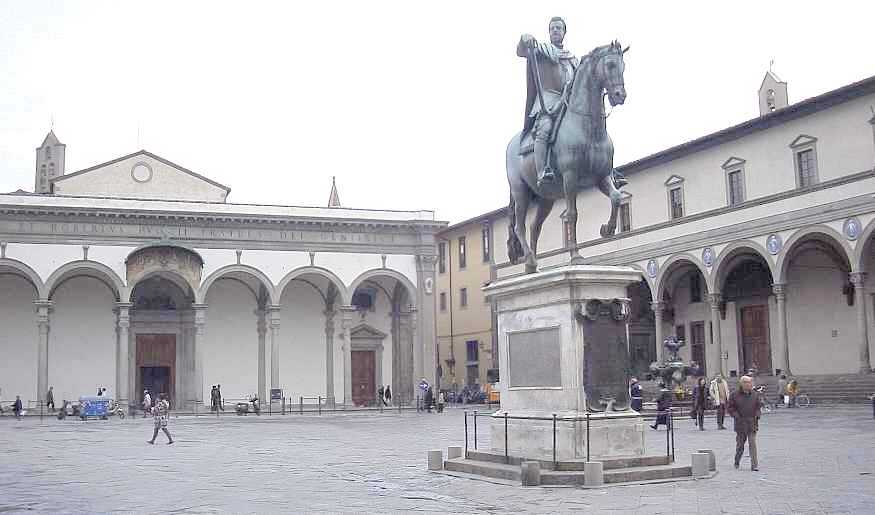
Our last full day in Florence started with an early morning run through the garden district, then a bus ride and walk back to the north end of the centro storico to retrace the previous day's steps through this town's most architecturally beautiful square, the Piazza Santissima Annunziata. This is truly square (or at least rectangle) shaped and is surrounded by early Renaissance loggias, two of which can be seen in the picture at the top of the page. Despite the traffic, this is a placid place; the buildings seem to fit the human scale well. College kids hang out on the porches, dodging rain (of which there was plenty.)
To the right is the oldest orphanage in Europe (1445) called the Spedale degli Innocenti. In the wall but hidden by the statue in the above picture is a no longer functioning (since 1875) lazy susan where unwanted babies could be swiveled around to the orphanage inside. Above each of the pillars are round glazed terra cotta babies in blue, the best known works of Andrea della Robbia.
This loggia/porch was Brunelleschi's (the Duomo Dome doyen) first major work and was often copied, including eventually two of the other sides of this site which gives this square the consistent appearance one finds in the high Renaissance piazzas in Rome where Michelangelo essentially reengineered building facades. Brunelleschi's porch here was truly revolutionary: while it retained much gothic influence, its pillars and geometry helped usher in the Renaissance.
On the left side of the picture at the top of this page is the entrance to the Church Santissima Annunziata where the Servite religious order began. Just inside is Michelozzo's large cloister. Once open to the elements, it is now glass covered so it looks like a huge vestibule. Around the walls are Andrea del Sarto frescoes in pretty bad shape; (the glass came too late). Inside, the church is detailed in Baroque with the sanctuary/tabernacle right by the front door. Go figure! That's not all: Andrea del Sarto's greatest masterpiece (called the Madonna with a Sack!) is kept behind locked doors.
Outside, while the square is resolutely Renaissance, it still gets no respect. Passing cars provide ample pollution, traffic, and noise--typical Italian responses to art that we in the States would air condition until all the nudes put on cardigans. On the bright side, at least the Italians didn't make this square into a parking lot.
Afterwards we made our way past two more churches on the north side of the Arno river: The first was Santa Trinita (an architectural smorgasbord from 11th century Romanesque through late 16th century Baroque. Its neighborhood is heavily trafficked but populated with high Renaissance buildings and Roman obelisks. A block to the south, its eponymous bridge, Ponte Santa Trinita spans the Arno -- supposedly this is Michelangelo designed and the most beautiful bridge in Florence even though the exiting Germans blew it up. After WWII, the Florentines dug the corner statues out of the riverbed mud and reassembled the bridge.
In fact, the only bridge the retreating Germans spared was the Ponte Vecchio (Old Bridge). They blew up buildings at each end to block the roadway to slow up the Americans. Obviously they planned on bringing the family back on holidays once things calmed down and they invented the Euro. Here's a view of Ponte Vecchio taken from Ponte Santa Trinita:
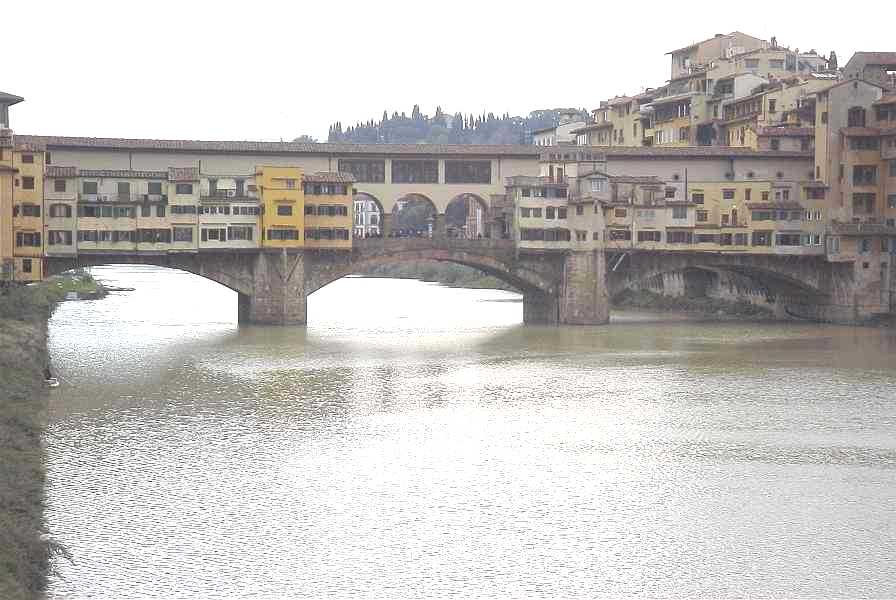
The lower stories of this bridge are filled with jewelry shops. The upper floor is a passageway used by the Medicis so they wouldn't have to mingle with the townspeople as they went from ruling in the Piazza Vecchio to living in the Pitti Palace on the other side of the river. (They came a long way in a few generations from their founder who didn't want to flaunt his wealth).
Our last stop on the North side of the Arno was the Franciscan Ognissanti, the Italian mouthful for All Saints Church. We found the front of the church completely covered with scaffolding, another gift (temporary, of course) of the ruling communist party to its eternal enemy, the Church. Maybe when we return to Florence we'll be able to see the front, the earliest Baroque façade in Florence. Inside are the typical Ghirlandaio frescoes, etc. However, in this case we have a bit of a rivalry as Ghirlandaio with a fresco of St. Jerome tries to one-up his rival Botticelli whose St. Augustan rests on the opposite wall of the nave -- leaving these two doctors of the church in a blinking contest. We're not sure who won the fresco match but Botticelli ended up getting buried in the church as did the most famous son of one of the parish's families: the explorer Amerigo Vespucci (whose face also appears in another Ghirlandaio Ognissanti fresco along with several of his relatives who were agents and mistresses of the Medici.). Not buried here is St. Francis of Assisi but somehow he left behind his habit worn during the stigmata. Quite a mix of all saints and many sinners.
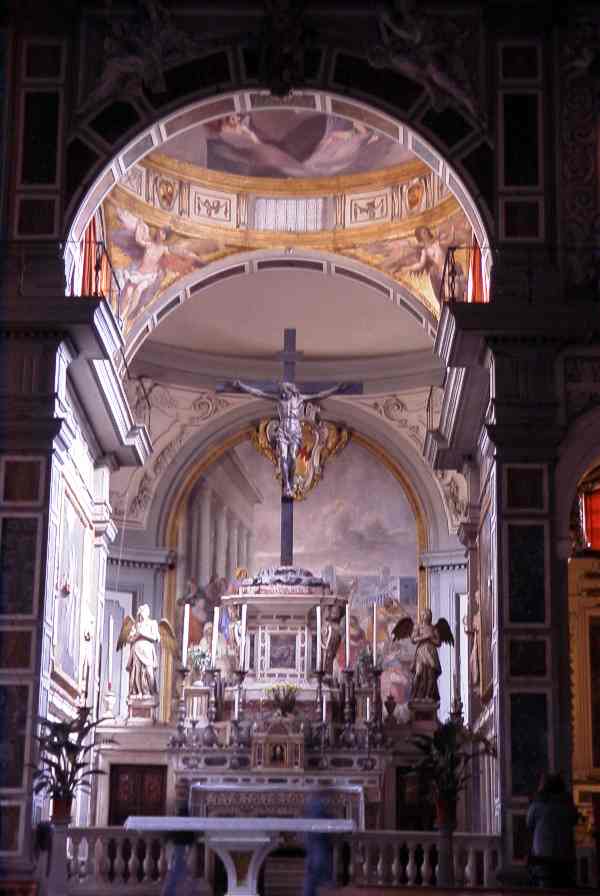
In search of another famous Ghirlandaio fresco of the last supper, we found the entrance to the cloister through the scaffolding and tried to make our way inside. Unfortunately, an international conference was in progress and we couldn't make it past the first arch.
We then crossed the Arno to spend the rest of the day on the South side, called the Oltrarno (which means "over the Arno"). This was the other side of the tracks (long before there were tracks) until the Medici built their Palazzo Pitti here in 1550. Staying close to the river, we walked by (and attempted to enter) several locked churches with interesting domes. Finally we came to the Square of Santo Spirito, one of the few green-filled Florentine spaces by day, but a spot to buy heroin at night -- not all of the habits in this town come from St. Francis.
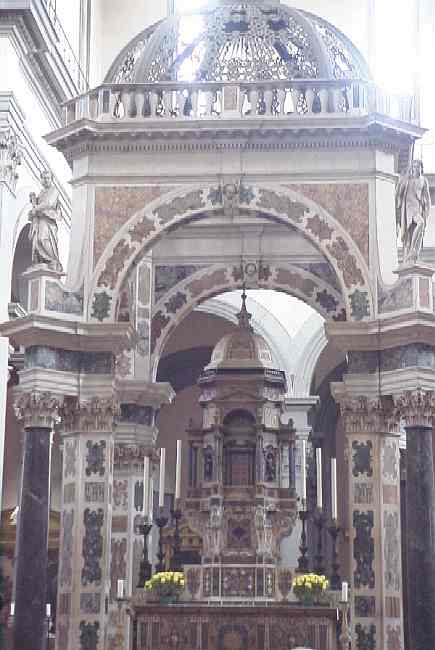
Again an unfinished outside masked a Brunelleschi high renaissance interior. (OK, thanks for not making me remind you that he's the Duomo Dome guy. He died two years into this project so you probably won't be tested on him again.) Above is a close-up of the altar that didn't quite come out, the picture that is; the altar's pretty spectacular. (I have no excuse, Brunelleschi let in lots of outside light). The place has 38 side altars, all of them individually named and teeming with art works.
We could see the Renaissance cloister through the famous sacristy of this church but thought we had to buy tickets to get in. So we went outside, spent the money, and came back in through a different door to find ourselves in the biggest Florentine rip-off, the Santo Spirito Refectory "Museum" -- a hodgepodge of stones scattered through the old Augustan fathers dining room. I've seen dining areas this sloppy before, but at least I didn't have to pay for the privilege.
We quickly retraced our steps and wound up soon inside the Santo Spirito Cloister. This is one of the best Renaissance courtyards. Here's a view showing the arches and a bit of the modest façade of the attached church:
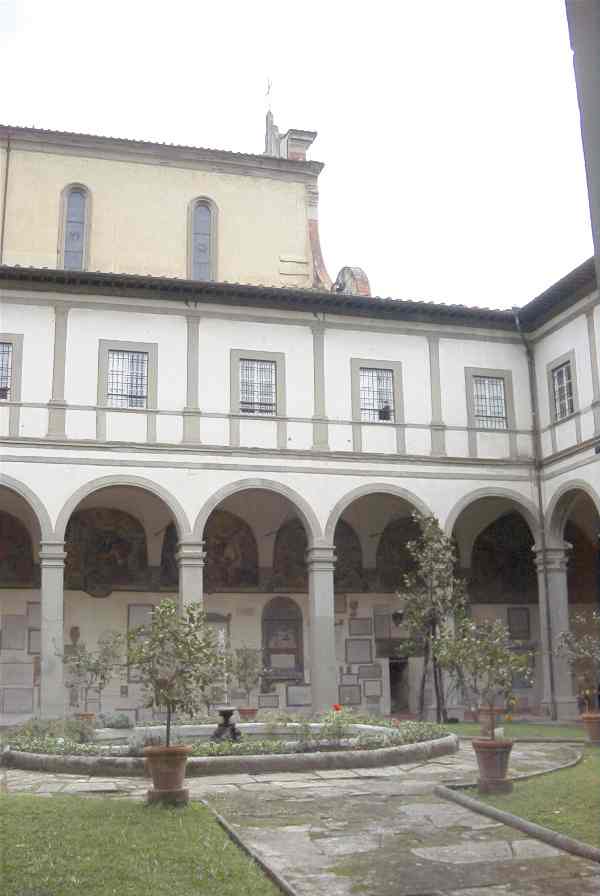
Within those arches are frescoes and gravestones. Here's a typical one showing the grave with a fresco overhead:
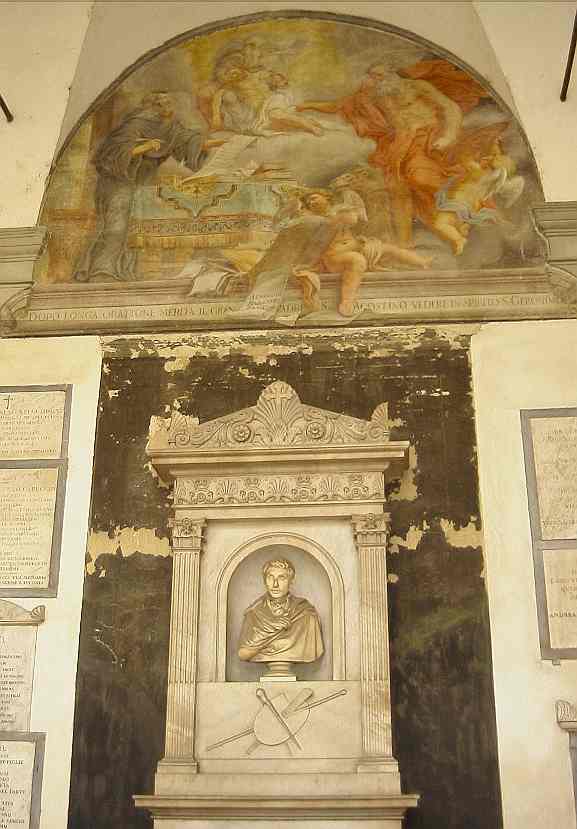
By now it was getting to be lunch time. We wandered around the square trying to get a restaurant that matched our temperament. Finally we settled for a great spot two blocks down the road. The delicous Tuscan food was only the start. We Americans complain about European plumbing but this was the first restroom I've ever been in that was fully automated: I'm not talking about just the retractable towel machines and electric eyes that turn water on and off -- every airport is getting those (Maybe to make up for the declining service of flight attendants?). But this place had everything robotized -- use your imagination (but hold the email). We're talking feats of engineering here equivalent to you-know-who's Duomo dome. Maybe Leonardo time-traveled forward here.
After hitting the eject button, we made our way to our next stop on a truly great afternoon: the seminal room of Renaissance painting -- the Brancacci chapel. Please join us by clicking here.
Where do you want to go today? Here's a few choices:
